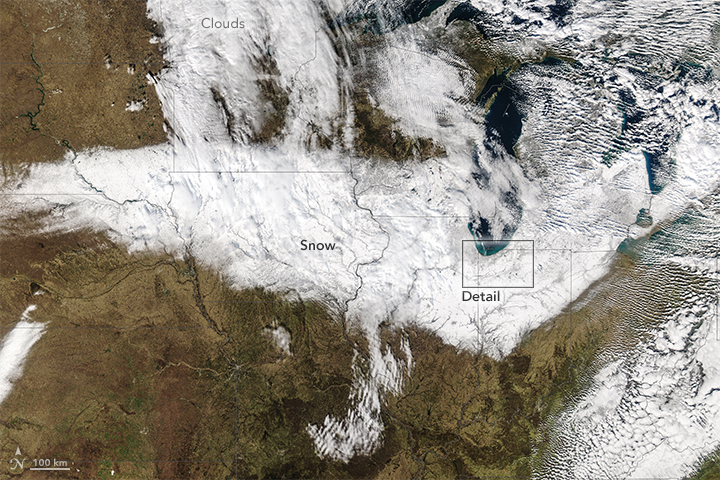


Much of the midwestern United States was drier and significantly warmer than normal in October and November 2015. So when snow blanketed the region from South Dakota to Ohio on November 20–21, it probably gave some people weather whiplash. For an area that is quite familiar with snow, it was still a storm for the history books, with a few records set for the highest snowfall totals for a first snow of the year.
At Chicago’s O’Hare International Airport, 11.2 inches (28.4 cm) of snowfall were recorded by the time the storm moved out on November 21. It was the second highest November snowfall since records were started in 1884 and the highest total for the first snow of the season. A new record for first snowfall also was set in Rockford, Illinois (8.8 inches or 22.4 cm). Nearly 800 flights into and out of Chicago were canceled by the snow.
The long-term average November snowfall for Chicago is 1.4 inches, and the average date of the first snow is December 7, according to The Weather Channel. Last winter, Chicago did not accumulate 6 inches of snow until January 5, 2015.
The Moderate Resolution Imaging Spectroradiometer (MODIS) on NASA’s Aqua satellite caught a glimpse of the snowy Midwest at 1:15 p.m. Central Standard Time (19:15 Universal Time) on November 22, 2015. Urban areas tend to appear more gray than white amidst the wide swath of snow.
In its report about the storm, meteorologists from the Chicago office of the National Weather Service wrote: “Interestingly, prior to Saturday the average temperature for the month had been running 6.5 degrees above normal. So this could end up being one of the warmer Novembers, as well as one of the snowiest.” Staff at The Weather Channel also noted that in the past five strong El Niños (1997-98, 1982-83, 1972-73, 1965-66, and 1957-58), Chicago saw snowfall totals reduced by a third to half.
According to the Midwestern Regional Climate Center, at least 51 stations across the U.S. Midwest recorded snowfall of at least 10 inches from the November 20–21 event. Tea, South Dakota, measured 18 inches; Grayslake, Illinois, caught 16 inches; Footville, Wisconsin, saw 17 inches; and Bloomfield, Nebraska, reported 16 inches.
NASA images by Jeff Schmaltz, LANCE/EOSDIS Rapid Response. Caption by Mike Carlowicz.